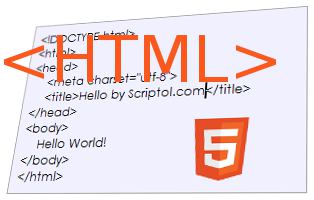HTML, web page tag language and interfaces
It is used to write web pages, and is originally a standard document format displayed locally by the browser or the latest text processing. But it became the UI language for web applications with version 5 and thus supplanted Flash.

HTML, or "HyperText Markup Language," is a subset of SGML (invented by IBM in 1969), defined by the W3C consortium. This is the document description language that uses tags for properties. This is a format recognized by web browsers. DHTML, "Dynamic HTML" - a combination of HTML and JavaScript. CSS, "Cascading Style Sheet," adds word processing style sheets to HTML.
Development stalled since version 4 as W3C polarized on XHTML, but failed to reach consensus on its definition.
An independent initiative, WHATWG thus relaunched the standard as HTML 5, which caused W3C to join this new format and make it current.
HTML 5 is no longer a document format, but an interface language for online applications or even with new operating systems such as Firefox OS, Chrome OS, webOS for local applications. The JavaScript section of the site provides several examples of using HTML as the local application interface with Node.js, even if the programming language is PHP.
Initially, the language cannot be extended like XML. A developer cannot add new tags and assign them a role that browsers can consider. But HTML frameworks 5 implement the Web Components standard to give this extensibility, these are mainly Polymer, X-Tags from Mozilla and Angular. These client interface components can interact with the server using Ajax, WebSocket, WebRTC.
Descriptive tag syntax
The XML syntax derived from HTML is verbose, so it is often preferred by JSON for data files to be processed by the application, but has the advantage of readability.
- HTML is formed from tags, uses <> as separators.
- Unlike XML, tags are not necessarily closed. Unlike
- XML, tags have a predefined and standard value, recognizable by user agents (mostly browsers).
- Instructions not recognized by the rendering engine are ignored (as specified).
- Impositions of unlimited designs. Fewer tags are not containers.
Example: Minimal code to display "Hello world!."
<!DOCTYPE html>
<html>
<head>
<meta charset="utf-8">
<title>Salut le Monde</title>
</head>
<body>
<p>Salut, le Monde!</p>
</body>
</html>
The specifications of HTML and all standards on the Web are located on the W3C, the website of the consortium that defines the language.
Use the Validator tool to validate the HTML code.
Form objects in HTML 5 represent the code of all new objects to check whether they are implemented by the browser.
There are many HTML editors working in WYSIWYG mode (direct editing in the final presentation) and well designed. Here is the list:
